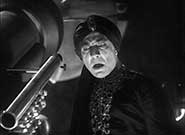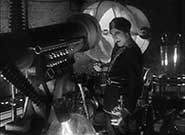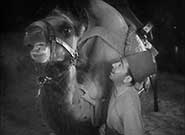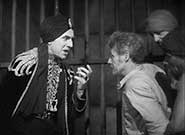 CHANDU
THE MAGICIAN (1932) Blu-ray
CHANDU
THE MAGICIAN (1932) Blu-rayDirectors: Marcel Varnel and William Cameron Menzies
Kino Lorber
 CHANDU
THE MAGICIAN (1932) Blu-ray
CHANDU
THE MAGICIAN (1932) Blu-rayPreviously available on DVD from 20th Century Fox Home Entertainment, both individually and in the Fox Horror Classics Vol. 2 set, rousing fantasy-adventure CHANDU THE MAGICIAN makes its high-definition debut on Blu-ray courtesy of Kino Lorber’s Studio Classics line.
 After
a wave of Chandu’s hand reveals the opening credits, a Hindu teacher (Nigel
de Brulier, CHARLIE CHAN IN EGYPT, ONE MILLION B.C.) in a temple high in an
Asian mountain range bestows upon hypnotist and adventurer Frank Chandler (Edmund
Lowe, GIFT OF GAB, DINNER AT EIGHT) the moniker of “Chandu” as he
is inducted into the sacred company of the yogi. After executing a variation
on the Indian rope trick, separating and reintegrating his “astral body”
with his physical form, and performing a fire walk to demonstrate his supernatural
powers, Chandu is shown the image of power-mad super-villain Roxor (Bela Lugosi,
THE DEATH KISS, WHITE ZOMBIE) in a crystal ball by the venerable yogi, who admonishes
the newly christened magician to go forth and “conquer the evils that
threaten mankind.” Chandu’s sister Betty Lou (June Vlasek [Lang],
WHITE HUNTER) and husband Robert Regent (Henry B. Walthall, DANTE’S INFERNO,
THE DEVIL-DOLL) relocate to Cairo, where Robert works feverishly perfecting
a “death ray,” which he tests by vaporizing a huge stone slab.
After
a wave of Chandu’s hand reveals the opening credits, a Hindu teacher (Nigel
de Brulier, CHARLIE CHAN IN EGYPT, ONE MILLION B.C.) in a temple high in an
Asian mountain range bestows upon hypnotist and adventurer Frank Chandler (Edmund
Lowe, GIFT OF GAB, DINNER AT EIGHT) the moniker of “Chandu” as he
is inducted into the sacred company of the yogi. After executing a variation
on the Indian rope trick, separating and reintegrating his “astral body”
with his physical form, and performing a fire walk to demonstrate his supernatural
powers, Chandu is shown the image of power-mad super-villain Roxor (Bela Lugosi,
THE DEATH KISS, WHITE ZOMBIE) in a crystal ball by the venerable yogi, who admonishes
the newly christened magician to go forth and “conquer the evils that
threaten mankind.” Chandu’s sister Betty Lou (June Vlasek [Lang],
WHITE HUNTER) and husband Robert Regent (Henry B. Walthall, DANTE’S INFERNO,
THE DEVIL-DOLL) relocate to Cairo, where Robert works feverishly perfecting
a “death ray,” which he tests by vaporizing a huge stone slab.
 Roxor’s
henchmen kidnap Robert, spiriting him away to Roxor’s temple fortress
at Meidum, and Chandu materializes in the Regent home, pledging his help in
finding Betty Lou’s captive husband. Princess Nadji (Irene Ware, THE RAVEN
[1935] ), descendant of a long line of Egyptian kings, and former flame of Chandu,
is summoned to Roxor’s fortress, where he demands the allegiance of Nadji’s
people, threatening to “drown them like rats” and destroy all the
works of civilization with the aid of Regent’s death ray if they resist,
his ultimate goal being to return humanity to savagery so he can rule over all.
Chandu, shadowing their meeting undercover, sets the temple on fire as a diversion
and helps Nadji make her escape, carrying her through the flames unharmed. While
Chandu is still in love with Nadji, she rejects at his advances because “her
life belongs to her subjects.” After surviving an attempted poisoning
by one of Roxor’s minions, Chandu and Nadji locate his lair with the aid
of a crystal ball.
Roxor’s
henchmen kidnap Robert, spiriting him away to Roxor’s temple fortress
at Meidum, and Chandu materializes in the Regent home, pledging his help in
finding Betty Lou’s captive husband. Princess Nadji (Irene Ware, THE RAVEN
[1935] ), descendant of a long line of Egyptian kings, and former flame of Chandu,
is summoned to Roxor’s fortress, where he demands the allegiance of Nadji’s
people, threatening to “drown them like rats” and destroy all the
works of civilization with the aid of Regent’s death ray if they resist,
his ultimate goal being to return humanity to savagery so he can rule over all.
Chandu, shadowing their meeting undercover, sets the temple on fire as a diversion
and helps Nadji make her escape, carrying her through the flames unharmed. While
Chandu is still in love with Nadji, she rejects at his advances because “her
life belongs to her subjects.” After surviving an attempted poisoning
by one of Roxor’s minions, Chandu and Nadji locate his lair with the aid
of a crystal ball.
 In
his death ray laboratory, Roxor’s henchman is punished for the failed
poisoning by having his eyes burned out with a double-pronged hot iron poker,
with which Roxor then threatens Robert to force him to make the death ray operational.
A stone statue come to life traps Chandu, his alcoholic sidekick Miggles (Herbert
Mundin, TARZAN ESCAPES, THE ADVENTURES OF ROBIN HOOD), and Nadji in a chamber
of the temple. Making their escape, Chandu clouds the minds of Roxor’s
armed guards, who see their rifles as hissing, coiled snakes. Meanwhile, Roxor
has removed Regent to another location, and now threatens to harm his daughter
Dorothy (Virginia Hammond, ROMEO AND JULIET [1936]) if he doesn’t cooperate.
Disguised as an unkempt beggar, Chandu sends his astral body to distract Roxor’s
guard while he rescues Dorothy, alerting Roxor to his presence.
In
his death ray laboratory, Roxor’s henchman is punished for the failed
poisoning by having his eyes burned out with a double-pronged hot iron poker,
with which Roxor then threatens Robert to force him to make the death ray operational.
A stone statue come to life traps Chandu, his alcoholic sidekick Miggles (Herbert
Mundin, TARZAN ESCAPES, THE ADVENTURES OF ROBIN HOOD), and Nadji in a chamber
of the temple. Making their escape, Chandu clouds the minds of Roxor’s
armed guards, who see their rifles as hissing, coiled snakes. Meanwhile, Roxor
has removed Regent to another location, and now threatens to harm his daughter
Dorothy (Virginia Hammond, ROMEO AND JULIET [1936]) if he doesn’t cooperate.
Disguised as an unkempt beggar, Chandu sends his astral body to distract Roxor’s
guard while he rescues Dorothy, alerting Roxor to his presence.
 Returning
to his fortress at Meidum, Roxor makes a final demand that Robert show him how
to operate the now functional death ray, and forces him to write a letter to
Dorothy, doctoring it with “invisible ink” to lure her into returning
to the temple, where Chandu and Nadji are now also being held captive. Recreating
one of the goddess Isis’s favorite punishments, they inter Chandu alive
in a sarcophagus, which is weighted and cast into the Nile, and Betty Lou, son
Bobby, and Dorothy are placed in a cell with a slowly collapsing floor over
a rocky, water-filled pit. Robert capitulates to Roxor’s demands, who
begins his death ray assault on London and Paris, and forces himself on Princess
Nadji.
Returning
to his fortress at Meidum, Roxor makes a final demand that Robert show him how
to operate the now functional death ray, and forces him to write a letter to
Dorothy, doctoring it with “invisible ink” to lure her into returning
to the temple, where Chandu and Nadji are now also being held captive. Recreating
one of the goddess Isis’s favorite punishments, they inter Chandu alive
in a sarcophagus, which is weighted and cast into the Nile, and Betty Lou, son
Bobby, and Dorothy are placed in a cell with a slowly collapsing floor over
a rocky, water-filled pit. Robert capitulates to Roxor’s demands, who
begins his death ray assault on London and Paris, and forces himself on Princess
Nadji.
 Based
on the hugely popular radio serial of the same name starring radio and movie
actor and voice artist Gayne Whitman (THE MASKED MARVEL, ONE GIRL’S CONFESSION),
which originally ran from 1931 to 1936 and was revived in 1948, broadcasting
it’s last episode in September 1950, CHANDU THE MAGICIAN was produced
by Fox Film Corporation three years before their merger with Twentieth Century
Pictures. Marcel Varnel (PUBLIC NUISANCE NO. 1) and William Cameron Menzies
(THINGS TO COME, INVADERS FROM MARS) share directing credits, Varnel presumably
handling the dialogue scenes while Menzies supervised the production design
and special effects sequences, which are generally well done except for a few
moments of unconvincing process work. Similar in feel and tone to movie serials
of the era, if a bit more intelligent and satisfying, CHANDU benefits greatly
from Lugosi’s over-the-top performance, the imaginative and impressive
set designs, and a snappy pace that rarely lets up. Herbert Mundin is faintly
amusing (and somewhat eyebrow-raising today) as booze-swilling camel jockey
Miggles—wearing a fez, hallucinating his own mini-me and mini camel, and
tippling almost constantly—although as 1930s comedy relief characters
go, Miggles is pretty tolerable. Modern viewers’ closest frame of reference
for CHANDU will likely be Steven Spielberg’s INDIANA JONES movies, which,
of course, were in part homage to 1930s/1940s chapter plays. With it’s
blending of primitive electrical technology, historical fantasy, and white magic,
CHANDU will probably also hold interest for enthusiasts of the current steampunk
craze (though technically CHANDU would more properly be categorized as “dieselpunk”).
Based
on the hugely popular radio serial of the same name starring radio and movie
actor and voice artist Gayne Whitman (THE MASKED MARVEL, ONE GIRL’S CONFESSION),
which originally ran from 1931 to 1936 and was revived in 1948, broadcasting
it’s last episode in September 1950, CHANDU THE MAGICIAN was produced
by Fox Film Corporation three years before their merger with Twentieth Century
Pictures. Marcel Varnel (PUBLIC NUISANCE NO. 1) and William Cameron Menzies
(THINGS TO COME, INVADERS FROM MARS) share directing credits, Varnel presumably
handling the dialogue scenes while Menzies supervised the production design
and special effects sequences, which are generally well done except for a few
moments of unconvincing process work. Similar in feel and tone to movie serials
of the era, if a bit more intelligent and satisfying, CHANDU benefits greatly
from Lugosi’s over-the-top performance, the imaginative and impressive
set designs, and a snappy pace that rarely lets up. Herbert Mundin is faintly
amusing (and somewhat eyebrow-raising today) as booze-swilling camel jockey
Miggles—wearing a fez, hallucinating his own mini-me and mini camel, and
tippling almost constantly—although as 1930s comedy relief characters
go, Miggles is pretty tolerable. Modern viewers’ closest frame of reference
for CHANDU will likely be Steven Spielberg’s INDIANA JONES movies, which,
of course, were in part homage to 1930s/1940s chapter plays. With it’s
blending of primitive electrical technology, historical fantasy, and white magic,
CHANDU will probably also hold interest for enthusiasts of the current steampunk
craze (though technically CHANDU would more properly be categorized as “dieselpunk”).
 While
CHANDU is firmly in the mold of a 1930s serial, it soars above the typical chapter
play of the time with its stylized mise-en-scène and imaginative set
pieces: Lugosi’s Roxor, clad head to toe in black, with jodhpurs, Nehru
collar, turban, cloak, and a wide cummerbund, and Chandu in pith helmet or turban
and swirling cape; the exotic, magical yogic ceremony; the imposing, monumental
sets of Roxor’s temple lair and death ray laboratory; the surreal living
stone statue; a row of mummy sarcophagi lining the temple walls that open out
to disgorge Roxor’s rifle-toting minions; the pile of skeletons at the
bottom of the gorge outside the entrance to Roxor’s fortress; uncredited
Kenneth Strickfaden’s (FRANKENSTEIN, MONSTROSITY) laboratory equipment
and crackling electrical effects; a cool sequence where the camera glides eerily
through the corridors of Roxor’s fortress at Meidum; and the final death
ray assault on Europe. CHANDU THE MAGICIAN was successful enough to spawn the
1934 12-chapter serial THE RETURN OF CHANDU, with Lugosi stepping into the role
of Chandu and battling the black magic cult of Ubasti on the island of Lemuria,
which was reedited into a 70-minute feature released the following year as CHANDU
ON THE MAGIC ISLAND. For fantasy-adventure fans, CHANDU THE MAGICIAN makes a
great art deco double bill with the 1935 version of SHE (the first talkie edition,
but the sixth cinematic adaptation of Sir H. Rider Haggard’s classic adventure
novel).
While
CHANDU is firmly in the mold of a 1930s serial, it soars above the typical chapter
play of the time with its stylized mise-en-scène and imaginative set
pieces: Lugosi’s Roxor, clad head to toe in black, with jodhpurs, Nehru
collar, turban, cloak, and a wide cummerbund, and Chandu in pith helmet or turban
and swirling cape; the exotic, magical yogic ceremony; the imposing, monumental
sets of Roxor’s temple lair and death ray laboratory; the surreal living
stone statue; a row of mummy sarcophagi lining the temple walls that open out
to disgorge Roxor’s rifle-toting minions; the pile of skeletons at the
bottom of the gorge outside the entrance to Roxor’s fortress; uncredited
Kenneth Strickfaden’s (FRANKENSTEIN, MONSTROSITY) laboratory equipment
and crackling electrical effects; a cool sequence where the camera glides eerily
through the corridors of Roxor’s fortress at Meidum; and the final death
ray assault on Europe. CHANDU THE MAGICIAN was successful enough to spawn the
1934 12-chapter serial THE RETURN OF CHANDU, with Lugosi stepping into the role
of Chandu and battling the black magic cult of Ubasti on the island of Lemuria,
which was reedited into a 70-minute feature released the following year as CHANDU
ON THE MAGIC ISLAND. For fantasy-adventure fans, CHANDU THE MAGICIAN makes a
great art deco double bill with the 1935 version of SHE (the first talkie edition,
but the sixth cinematic adaptation of Sir H. Rider Haggard’s classic adventure
novel).
 CHANDU
THE MAGICIAN is presented in its original 1.33:1 aspect ratio, transferred in
1080p MPEG-4 AVC high definition. The source print is far from pristine, but
still very watchable. Black and white levels, grayscale, and sharpness and detail
are all more than acceptable for a movie from the early 1930s, and grain is
generally tight and unobtrusive, with a few instances here and there where it’s
more conspicuous. The image shows fairly constant light to moderate speckling
and blemishing, some barely noticeable black lining, and occasional stretches
with light bands of “snowy” speckling along the sides of the frame,
although it’s never heavy enough to distract from enjoyment of the movie.
Audio is reasonably clear for a movie of its vintage, with no perceptible hiss,
hum, crackles, or pops.
CHANDU
THE MAGICIAN is presented in its original 1.33:1 aspect ratio, transferred in
1080p MPEG-4 AVC high definition. The source print is far from pristine, but
still very watchable. Black and white levels, grayscale, and sharpness and detail
are all more than acceptable for a movie from the early 1930s, and grain is
generally tight and unobtrusive, with a few instances here and there where it’s
more conspicuous. The image shows fairly constant light to moderate speckling
and blemishing, some barely noticeable black lining, and occasional stretches
with light bands of “snowy” speckling along the sides of the frame,
although it’s never heavy enough to distract from enjoyment of the movie.
Audio is reasonably clear for a movie of its vintage, with no perceptible hiss,
hum, crackles, or pops.
 An
audio commentary by Gregory William Mank, recorded for the 2008 Fox DVD release,
is included as the Blu-ray’s primary extra. Mank provides background on
the massively popular radio serial—which Ray Bradbury claimed to have
taken inspiration from—comparing it to the recent Harry Potter phenomenon;
discusses the creation of the screenplay and special effects, the distribution
of the film, the careers of cameraman James Wong Howe and co-directors Varnel
and Menzies, the salaries and other credits of the major players, and the history
of death rays in movies; reads excerpts from contemporary reviews; relates trivia
gleaned from an interview he conducted with Bela’s fifth wife, Hope Lininger;
addresses the friendship and alleged feud between Boris Karloff and Lugosi;
describes the frightening chaos created by a 10,000-strong mob of fans at the
funeral of Lowe’s wife, actress Lilyan Tashman; and reveals the surprising
original meaning of the name Chandu.
An
audio commentary by Gregory William Mank, recorded for the 2008 Fox DVD release,
is included as the Blu-ray’s primary extra. Mank provides background on
the massively popular radio serial—which Ray Bradbury claimed to have
taken inspiration from—comparing it to the recent Harry Potter phenomenon;
discusses the creation of the screenplay and special effects, the distribution
of the film, the careers of cameraman James Wong Howe and co-directors Varnel
and Menzies, the salaries and other credits of the major players, and the history
of death rays in movies; reads excerpts from contemporary reviews; relates trivia
gleaned from an interview he conducted with Bela’s fifth wife, Hope Lininger;
addresses the friendship and alleged feud between Boris Karloff and Lugosi;
describes the frightening chaos created by a 10,000-strong mob of fans at the
funeral of Lowe’s wife, actress Lilyan Tashman; and reveals the surprising
original meaning of the name Chandu.
 Also carried over from the DVD release are a short restoration comparison—revealing
that at least some cleanup, most likely digital, of more-conspicuous speckling
and spotting was performed—and the “Masters of Magic: The World
of Chandu” featurette (15:17), featuring contributions from familiar genre
historians and filmmakers Kim Newman, Ray Harryhausen, Bob Burns, Paul M. Jensen,
Steve Haberman, Christopher Wicking, and Mr. Mank, among others. It’s
a well made and interesting extra, but there appears to have been some kind
of mastering error in porting it to Blu-ray as the original 1.33:1 aspect ratio
has been “stretched” to approximately 1.66:1. I tried the disc in
two different Blu-ray players with two different digital TVs, and no matter
how the view mode was set (16x9, 4x3, side stretch, and so on), the picture
is either stretched to 1.66:1 or “squeezed” to less than 1.33:1.
Fortunately, the feature and other extras do not suffer from this error. Trailers
for Kino Lorber Blu-ray releases THE BLACK SLEEP (open matte, 1:36) and WHITE
ZOMBIE (1952 reissue, 2:46) are also included, but missing on the Blu-ray is
the nicely done still gallery of 45 images that was present on the 2008 release,
so completists will have to hang on to their DVD. The case cover insert features
reversible artwork, with original 1932 poster art as the alternate front cover.
Also carried over from the DVD release are a short restoration comparison—revealing
that at least some cleanup, most likely digital, of more-conspicuous speckling
and spotting was performed—and the “Masters of Magic: The World
of Chandu” featurette (15:17), featuring contributions from familiar genre
historians and filmmakers Kim Newman, Ray Harryhausen, Bob Burns, Paul M. Jensen,
Steve Haberman, Christopher Wicking, and Mr. Mank, among others. It’s
a well made and interesting extra, but there appears to have been some kind
of mastering error in porting it to Blu-ray as the original 1.33:1 aspect ratio
has been “stretched” to approximately 1.66:1. I tried the disc in
two different Blu-ray players with two different digital TVs, and no matter
how the view mode was set (16x9, 4x3, side stretch, and so on), the picture
is either stretched to 1.66:1 or “squeezed” to less than 1.33:1.
Fortunately, the feature and other extras do not suffer from this error. Trailers
for Kino Lorber Blu-ray releases THE BLACK SLEEP (open matte, 1:36) and WHITE
ZOMBIE (1952 reissue, 2:46) are also included, but missing on the Blu-ray is
the nicely done still gallery of 45 images that was present on the 2008 release,
so completists will have to hang on to their DVD. The case cover insert features
reversible artwork, with original 1932 poster art as the alternate front cover.
While big fans of CHANDU will surely be pleased with the HD upgrade of the feature itself, the imperfect presentation of the featurette and missing still gallery might give less forgiving viewers pause as to whether to double dip. I’m normally a big supporter of Kino Lorber’s Blu-ray releases, and own more of their Blu’s than those of any other video company, but DVD extras going missing on HD reissues is the bane of Blu-ray collectors and the Achilles’ heel of all too many BD releases (Olive Films is probably the worst offender on this score). I’d still heartily recommended this release for admirers of the movie, albeit with a minor caveat due to the flawed and missing extras. (Paul Tabili)